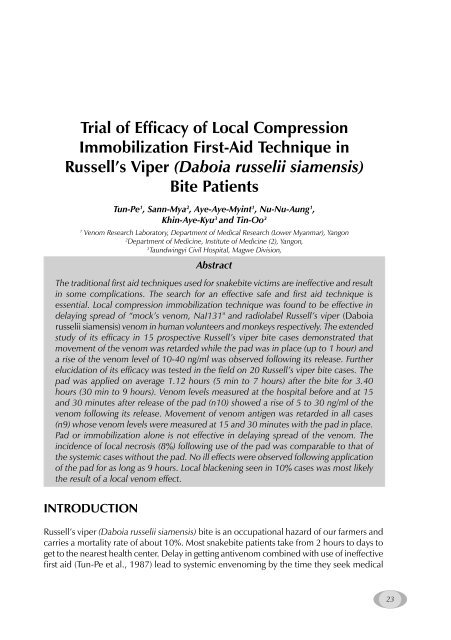Management of Snakebite and Research Management of Snakebite ...
Management of Snakebite and Research Management of Snakebite ...
Management of Snakebite and Research Management of Snakebite ...
You also want an ePaper? Increase the reach of your titles
YUMPU automatically turns print PDFs into web optimized ePapers that Google loves.
Trial <strong>of</strong> Efficacy <strong>of</strong> Local Compression<br />
Immobilization First-Aid Technique in<br />
Russell’s Viper (Daboia russelii siamensis)<br />
Bite Patients<br />
Tun-Pe1 , Sann-Mya2 , Aye-Aye-Myint1 , Nu-Nu-Aung1 ,<br />
Khin-Aye-Kyu3 <strong>and</strong> Tin-Oo3 1 Venom <strong>Research</strong> Laboratory, Department <strong>of</strong> Medical <strong>Research</strong> (Lower Myanmar), Yangon<br />
2Department <strong>of</strong> Medicine, Institute <strong>of</strong> Medicine (2), Yangon,<br />
3Taundwingyi Civil Hospital, Magwe Division,<br />
Abstract<br />
The traditional first aid techniques used for snakebite victims are ineffective <strong>and</strong> result<br />
in some complications. The search for an effective safe <strong>and</strong> first aid technique is<br />
essential. Local compression immobilization technique was found to be effective in<br />
delaying spread <strong>of</strong> “mock’s venom, NaI131" <strong>and</strong> radiolabel Russell’s viper (Daboia<br />
russelii siamensis) venom in human volunteers <strong>and</strong> monkeys respectively. The extended<br />
study <strong>of</strong> its efficacy in 15 prospective Russell’s viper bite cases demonstrated that<br />
movement <strong>of</strong> the venom was retarded while the pad was in place (up to 1 hour) <strong>and</strong><br />
a rise <strong>of</strong> the venom level <strong>of</strong> 10-40 ng/ml was observed following its release. Further<br />
elucidation <strong>of</strong> its efficacy was tested in the field on 20 Russell’s viper bite cases. The<br />
pad was applied on average 1.12 hours (5 min to 7 hours) after the bite for 3.40<br />
hours (30 min to 9 hours). Venom levels measured at the hospital before <strong>and</strong> at 15<br />
<strong>and</strong> 30 minutes after release <strong>of</strong> the pad (n10) showed a rise <strong>of</strong> 5 to 30 ng/ml <strong>of</strong> the<br />
venom following its release. Movement <strong>of</strong> venom antigen was retarded in all cases<br />
(n9) whose venom levels were measured at 15 <strong>and</strong> 30 minutes with the pad in place.<br />
Pad or immobilization alone is not effective in delaying spread <strong>of</strong> the venom. The<br />
incidence <strong>of</strong> local necrosis (8%) following use <strong>of</strong> the pad was comparable to that <strong>of</strong><br />
the systemic cases without the pad. No ill effects were observed following application<br />
<strong>of</strong> the pad for as long as 9 hours. Local blackening seen in 10% cases was most likely<br />
the result <strong>of</strong> a local venom effect.<br />
INTRODUCTION<br />
Russell’s viper (Daboia russelii siamensis) bite is an occupational hazard <strong>of</strong> our farmers <strong>and</strong><br />
carries a mortality rate <strong>of</strong> about 10%. Most snakebite patients take from 2 hours to days to<br />
get to the nearest health center. Delay in getting antivenom combined with use <strong>of</strong> ineffective<br />
first aid (Tun-Pe et al., 1987) lead to systemic envenoming by the time they seek medical<br />
23









